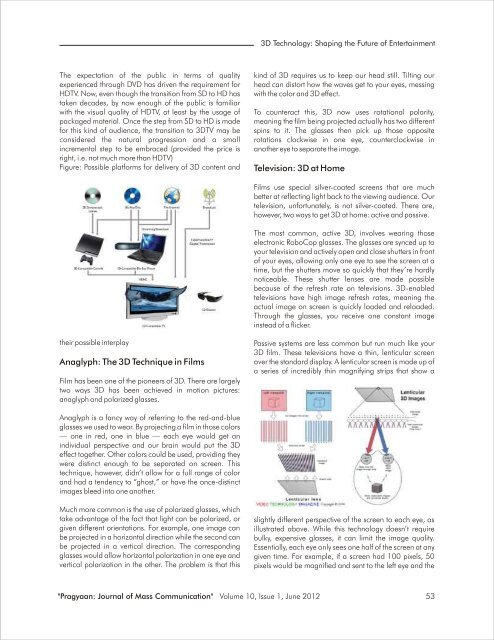Research Papers/Articles - Institute of Management Studies Dehradun
Research Papers/Articles - Institute of Management Studies Dehradun
Research Papers/Articles - Institute of Management Studies Dehradun
Create successful ePaper yourself
Turn your PDF publications into a flip-book with our unique Google optimized e-Paper software.
The expectation <strong>of</strong> the public in terms <strong>of</strong> quality<br />
experienced through DVD has driven the requirement for<br />
HDTV. Now, even though the transition from SD to HD has<br />
taken decades, by now enough <strong>of</strong> the public is familiar<br />
with the visual quality <strong>of</strong> HDTV, at least by the usage <strong>of</strong><br />
packaged material. Once the step from SD to HD is made<br />
for this kind <strong>of</strong> audience, the transition to 3DTV may be<br />
considered the natural progression and a small<br />
incremental step to be embraced (provided the price is<br />
right, i.e. not much more than HDTV)<br />
Figure: Possible platforms for delivery <strong>of</strong> 3D content and<br />
their possible interplay<br />
Anaglyph: The 3D Technique in Films<br />
Film has been one <strong>of</strong> the pioneers <strong>of</strong> 3D. There are largely<br />
two ways 3D has been achieved in motion pictures:<br />
anaglyph and polarized glasses.<br />
Anaglyph is a fancy way <strong>of</strong> referring to the red-and-blue<br />
glasses we used to wear. By projecting a film in those colors<br />
— one in red, one in blue — each eye would get an<br />
individual perspective and our brain would put the 3D<br />
effect together. Other colors could be used, providing they<br />
were distinct enough to be separated on screen. This<br />
technique, however, didn’t allow for a full range <strong>of</strong> color<br />
and had a tendency to “ghost,” or have the once-distinct<br />
images bleed into one another.<br />
Much more common is the use <strong>of</strong> polarized glasses, which<br />
take advantage <strong>of</strong> the fact that light can be polarized, or<br />
given different orientations. For example, one image can<br />
be projected in a horizontal direction while the second can<br />
be projected in a vertical direction. The corresponding<br />
glasses would allow horizontal polarization in one eye and<br />
vertical polarization in the other. The problem is that this<br />
3D Technology: Shaping the Future <strong>of</strong> Entertainment<br />
kind <strong>of</strong> 3D requires us to keep our head still. Tilting our<br />
head can distort how the waves get to your eyes, messing<br />
with the color and 3D effect.<br />
To counteract this, 3D now uses rotational polarity,<br />
meaning the film being projected actually has two different<br />
spins to it. The glasses then pick up those opposite<br />
rotations clockwise in one eye, counterclockwise in<br />
another eye to separate the image.<br />
Television: 3D at Home<br />
Films use special silver-coated screens that are much<br />
better at reflecting light back to the viewing audience. Our<br />
television, unfortunately, is not silver-coated. There are,<br />
however, two ways to get 3D at home: active and passive.<br />
The most common, active 3D, involves wearing those<br />
electronic RoboCop glasses. The glasses are synced up to<br />
your television and actively open and close shutters in front<br />
<strong>of</strong> your eyes, allowing only one eye to see the screen at a<br />
time, but the shutters move so quickly that they’re hardly<br />
noticeable. These shutter lenses are made possible<br />
because <strong>of</strong> the refresh rate on televisions. 3D-enabled<br />
televisions have high image refresh rates, meaning the<br />
actual image on screen is quickly loaded and reloaded.<br />
Through the glasses, you receive one constant image<br />
instead <strong>of</strong> a flicker.<br />
Passive systems are less common but run much like your<br />
3D film. These televisions have a thin, lenticular screen<br />
over the standard display. A lenticular screen is made up <strong>of</strong><br />
a series <strong>of</strong> incredibly thin magnifying strips that show a<br />
slightly different perspective <strong>of</strong> the screen to each eye, as<br />
illustrated above. While this technology doesn’t require<br />
bulky, expensive glasses, it can limit the image quality.<br />
Essentially, each eye only sees one half <strong>of</strong> the screen at any<br />
given time. For example, if a screen had 100 pixels, 50<br />
pixels would be magnified and sent to the left eye and the<br />
"Pragyaan: Journal <strong>of</strong> Mass Communication" Volume 10, Issue 1, June 2012 53


